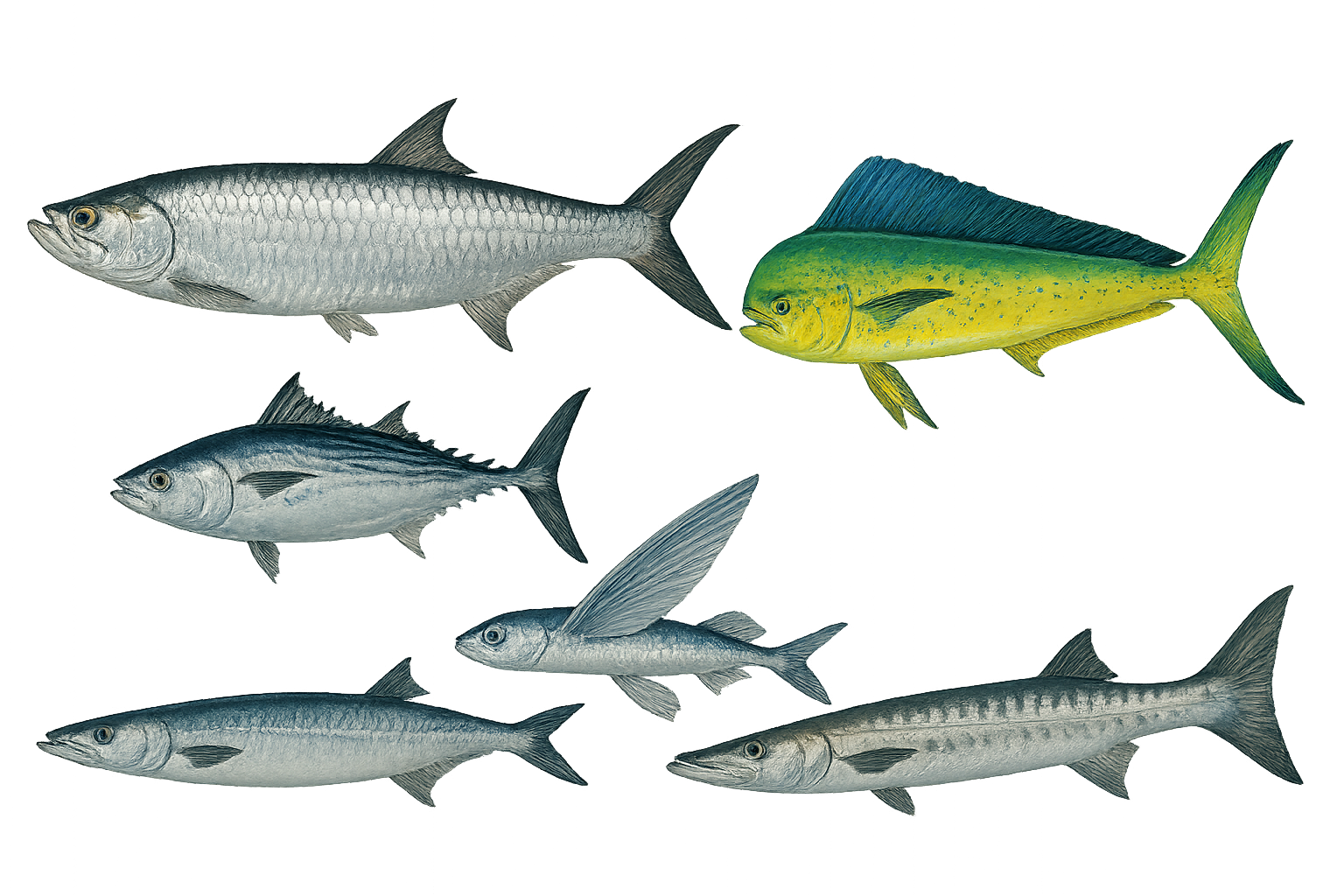A Guide to Jumping Fish in Curacao
. Tarpon (Sablá)
Large silver fish at the upper left. Known for powerful, full-body leaps and bright reflective scales.
2. Mahi-Mahi (Dolphinfish)
Bright yellow-green fish at the upper right. Recognizable by its vivid colors and tall dorsal fin.
3. Bonito / Little Tunny
Mid-sized tuna-family fish at the center left. Sleek, fast, with dark stripes along the back.
4. Flying Fish
Small silver-blue fish with winglike pectoral fins at the center-right. Glides long distances above the surface.
5. Barracuda
Long, slender predator at the bottom. Silver-grey body, pointed head, and distinctive sharp-toothed profile.
Below is your guide to understanding who’s doing the jumping, why they jump, and how to identify each species.
Why Do Fish Jump?
They’re hunting: Predators explode through schools of baitfish.
They’re escaping: Smaller fish launch out of the water to dodge larger hunters.
They’re displaying: Some species jump in courtship or territorial shows.
They’re oxygening: A few fish gulp air or roll near the surface in low-oxygen zones.
They’re just…fish being fish: Sometimes behavior has no dramatic explanation.
How to identify each fish:
Tarpon (Locally: “Sablá”)
How to recognize it:
Huge, silver, torpedo-shaped fish; often 3 to 6 feet long. You’ll see a bright flash of chrome and a dramatic full-body breach.
What it looks like when they jump:
Tarpon don’t just jump. They launch. Picture a steel missile erupting from the sea, often twisting midair before crashing back down with an echoing splash.
Fun facts:
Tarpon can grow over 250 pounds.
They’re “air breathers” and will roll at the surface, taking gulps of air.
Local fishermen call them “silver kings” and consider them among the strongest sport fish on Earth.
Where you’ll see them:
Cliff edges like Watamula, deep channels, and river mouths.
If the splash was huge, it was a tarpon.
Bonito, Skipjack & Little Tunny
How to recognize them:
Medium-sized tuna-family fish, shaped like slender torpedoes, often appearing in small groups.
What it looks like when they jump:
Quick, low jumps; more like a fast flick out of the water while they chase tightly packed baitfish. You may see multiple splashes in rapid succession.
Fun facts:
They can swim 40 miles per hour or more.
When they attack, the water in front of them ripples like a zipper opening.
Fishermen follow seabirds to find them: birds know where the tuna are feeding.
Where you’ll see them:
Anywhere with baitfish…which is almost everywhere around Curaçao.
Mahi-Mahi (Dolphinfish)
How to recognize it:
Bright greens, blues, and yellows (though you might only catch a flash of color). Slender but tall-bodied, with a distinctive curved forehead.
What it looks like when they jump:
High, athletic leaps — spectacular flips and arcs. Usually more common offshore, but Curaçao’s deep walls mean they can come surprisingly close.
Fun facts:
Mahi grow faster than almost any fish, reaching adult size in a year.
They form pairs or small groups and are often seen under floating debris.
Their colors change instantly depending on mood and movement.
Flying Fish
How to recognize them:
Small, silver-blue fish with long, winglike fins.
What it looks like when they jump:
Not just a jump. A flight. They burst from the water and glide for up to 200 meters, sometimes skipping off the surface.
Fun facts:
They can reach speeds of 60 km/h before takeoff.
They aren’t truly flying; they glide like paper airplanes.
Dolphins, mahi, and tuna chase flying fish, leading to incredible action near the surface.
Barracuda
Do barracuda jump? Rarely.
While barracuda are common in Curaçao, they almost never leap dramatically out of the water.
How to recognize it:
Long, thin, grey body; very fast; unmistakably pointed head with sharp teeth.
What it looks like when they jump:
A quick strike or short break of the surface, usually low and brief.
Fun facts:
They can accelerate faster than almost any fish near shore.
Barracuda often shadow snorkelers out of curiosity (harmlessly).
They hover near reef edges waiting for opportunity strikes.
The size and style of the splash
Sometimes you won’t see the fish at all. Only the explosion.
Here’s what to look for:
Huge splash, loud impact: Tarpon.
Rapid, multiple small splashes: Tuna chasing baitfish.
Long, skimming glides: Flying fish escaping predators.
Sudden swirl or boil on the surface: Barracuda or jacks attacking prey.
Bright flash of color: Mahi-mahi.
Best Times & Places
Best Times:
Early morning
One hour before sunset
During tidal changes

